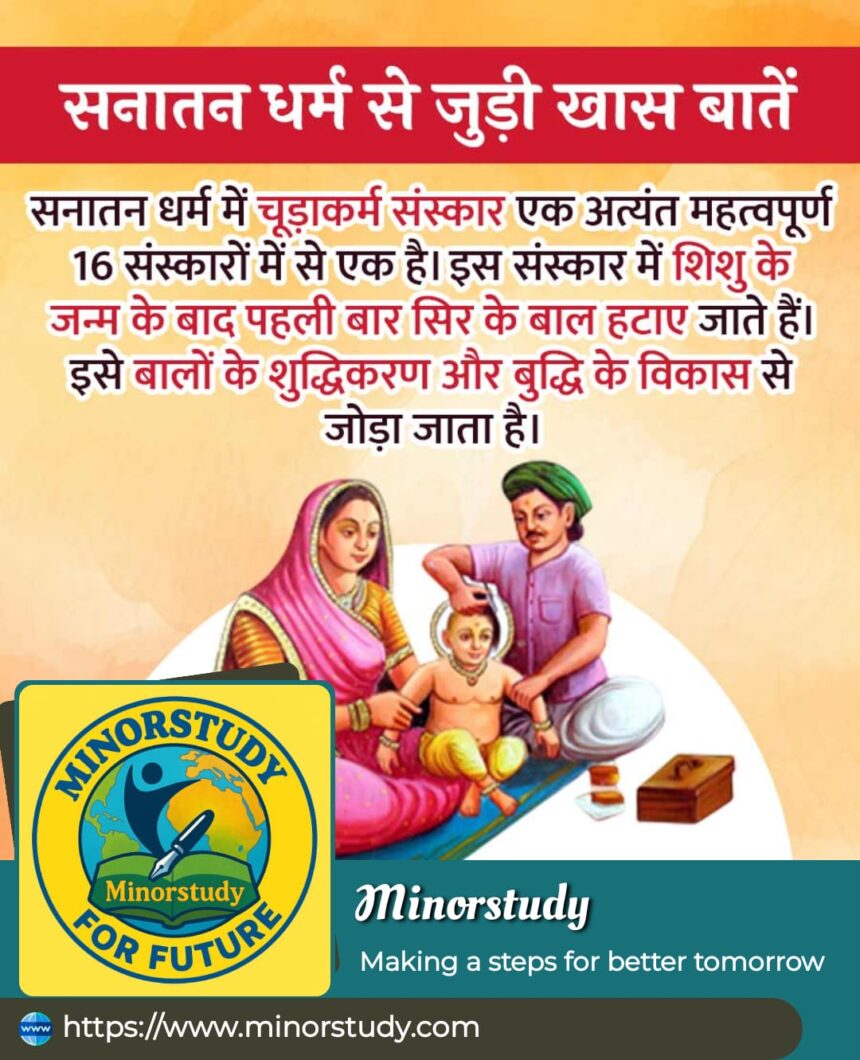🌼 7 Sacred Truths of Chudakarma Sanskar That Enrich a Child’s Spiritual Path
Sanatan Dharma, the eternal spiritual tradition of India, holds within its folds 16 major Sanskars (sacraments) that guide the soul’s journey from birth to death and even beyond. Among these, the Chudakarma Sanskar, also known as Mundan Sanskar, is a sacred ritual that celebrates not just physical change, but also purification, growth, and the awakening of higher intelligence.
- 🕉️ What is Chudakarma Sanskar?
- 📜 Ancient History and Origins of Chudakarma
- 🗓️ Timeline and Age for Performing Chudakarma
- 🪔 Rituals and Observance of the Ceremony
- 🔍 Spiritual and Scientific Significance
- 🧠 1. Development of Intellect
- 🌿 2. Detoxification and Health
- 🔥 3. Karma Cleansing
- 🧬 4. Energy Balance
- 🙏 5. Offering to Ancestors
- ❓ FAQs on Chudakarma Sanskar
- ❓ Is it compulsory in Sanatan Dharma?
- ❓ Why is the Choti or Shikha left on the head?
- ❓ Can girls also undergo Chudakarma?
- ❓ Why is the ritual performed at pilgrimage sites?
- ❓ Can the ceremony be done at home?
- 💐 Wishing Messages for Chudakarma Ceremony
- 📌 Important Points to Remember
- 🧠 Impact on Life and Society
- 📖 Conclusion: The Sacred Role of Chudakarma in Our Lives
This article explores the history, significance, rituals, observances, and deep human impact of Chudakarma Sanskar in more than 1200 words, offering both spiritual depth and relatable insights for modern families and cultural enthusiasts.
🕉️ What is Chudakarma Sanskar?
Chudakarma, also called Mundan or Tonsure Ceremony, is one of the sixteen essential rites (Shodasha Sanskaras) prescribed in Sanatan Dharma for an individual’s spiritual and psychological evolution. It refers to the first ceremonial shaving of a child’s head, usually performed between 1 and 3 years of age, typically for boys and sometimes for girls too, in specific traditions.
This Sanskar represents the shedding of past negative influences, awakening of intellect, and entry into a purified and dharmic phase of life.
📜 Ancient History and Origins of Chudakarma
The ritual of Chudakarma finds its origins in the Vedic scriptures, including the Grihya Sutras and Manusmriti, which outline this rite as an important part of a child’s upbringing and purification.
Vedic Connection: The Atharva Veda and Yajur Veda hint at the importance of removing hair as a symbol of discarding past impurities and beginning a fresh journey of life.
Rishi Traditions: Ancient rishis believed that hair stored karmic impressions from past births. Removing it would liberate the soul from unwanted baggage.
🗓️ Timeline and Age for Performing Chudakarma
The ideal time for Chudakarma Sanskar is determined by astrological factors, child’s health, and family tradition. Generally:
Age: Performed at end of the first year or during the third year.
Tithi (Auspicious Days): Usually done on Dwitiya, Tritiya, or Panchami Tithis, especially during Chaitra, Vaishakh, or Magh months.
Place: Often conducted at holy places like Kashi, Prayagraj, Haridwar, Rameshwaram, or family temples.
🪔 Rituals and Observance of the Ceremony
The process includes several deeply spiritual and symbolic steps:
Sankalp – The priest performs a Sankalp (vow) invoking deities and ancestors, stating the intention of the ritual.
Ganesha Puja – Removal of obstacles by invoking Lord Ganesha.
Havan – A sacred fire ritual is performed to purify the environment and bless the child.
Shaving the Head – The barber or priest shaves the child’s hair while mantras are recited.
Tying of Shikha – In some traditions, a small tuft of hair called Shikha or Choti is left to preserve spiritual energy.
Tarpan – Water and offerings are made to ancestors for blessings.
Annadan & Festivity – Guests are fed, and the child is blessed with gifts and well-wishes.
🔍 Spiritual and Scientific Significance
🧠 1. Development of Intellect
Vedic thought links hair removal with the awakening of medha shakti — the power of the intellect. By performing Chudakarma, the child is believed to become more receptive to learning and wisdom.
🌿 2. Detoxification and Health
Hair, especially in infancy, is believed to accumulate toxins from the womb and early life. Removing it helps in therapeutic cleansing, especially when followed by applying herbal pastes.
🔥 3. Karma Cleansing
The hair from past births is symbolically removed, thereby freeing the child from past karmic patterns and giving a fresh start on the path of Dharma.
🧬 4. Energy Balance
According to Ayurvedic and Yogic science, shaving the head helps in balancing body heat, maintaining calmness, and stimulating the nerves of the scalp.
🙏 5. Offering to Ancestors
The hair is sometimes immersed in holy rivers or offered to pitrs (ancestors) as a mark of gratitude and request for blessings.
❓ FAQs on Chudakarma Sanskar
❓ Is it compulsory in Sanatan Dharma?
While not legally obligatory, it is highly recommended in scriptures for spiritual and psychological purification.
❓ Why is the Choti or Shikha left on the head?
The Shikha acts as a spiritual antenna, protecting and preserving vital energy (ojas) as per ancient Yogic beliefs.
❓ Can girls also undergo Chudakarma?
Yes, in some traditions, girls also undergo tonsure — though more commonly for boys.
❓ Why is the ritual performed at pilgrimage sites?
Performing it in spiritually charged places amplifies the benefit and sanctity of the Sanskar.
❓ Can the ceremony be done at home?
Yes, with the presence of a qualified priest and adherence to proper ritual steps and mantras, it can be done at home.
💐 Wishing Messages for Chudakarma Ceremony
“Wishing divine blessings on this sacred Chudakarma Sanskar. May the child grow in wisdom, purity, and righteousness.”
“On this holy occasion of Mundan Sanskar, may the child’s life be filled with dharma, knowledge, and joy.”
“May this Sanskar mark the beautiful beginning of a life full of light and virtue.”
📌 Important Points to Remember
🕉️ Chudakarma is one of the 16 core Sanskars in Sanatan Dharma.
✂️ Symbolic of cleansing, intelligence development, and fresh beginnings.
🧠 Strong ties with intellect enhancement and karma removal.
🔥 Includes rituals like havan, mantra chanting, and ancestral offerings.
🌊 Often performed at spiritual locations with great sanctity.
🧠 Impact on Life and Society
👪 In Family
The event becomes a bonding moment, involving relatives, well-wishers, and community members. It brings the whole family together in spiritual joy.
📿 In Spiritual Growth
Even though the child may not remember the event, the energetic imprint and blessings shape their dharmic journey.
🧑🏫 In Culture and Education
The Sanskar also prepares the child for future Vedic learning (like Upanayan), connecting them to their cultural identity.
🌍 In Society
These rites preserve Sanatan traditions, strengthening the community’s cultural roots and ethical values.
📖 Conclusion: The Sacred Role of Chudakarma in Our Lives
In the tapestry of Sanatan Dharma, the Chudakarma Sanskar is more than a haircut. It is a spiritual milestone, a whisper of the ancient rishis into the ears of the next generation, saying — “Let go of the past, embrace the path of Dharma, and grow in purity and wisdom.”
Even in today’s fast-paced world, rituals like Chudakarma keep us anchored to our roots, reminding us that every life stage has a deeper meaning, and that childhood too has its sacred beginnings.








